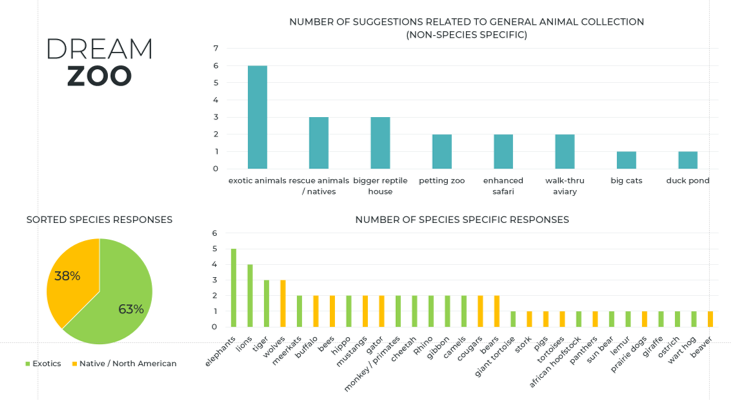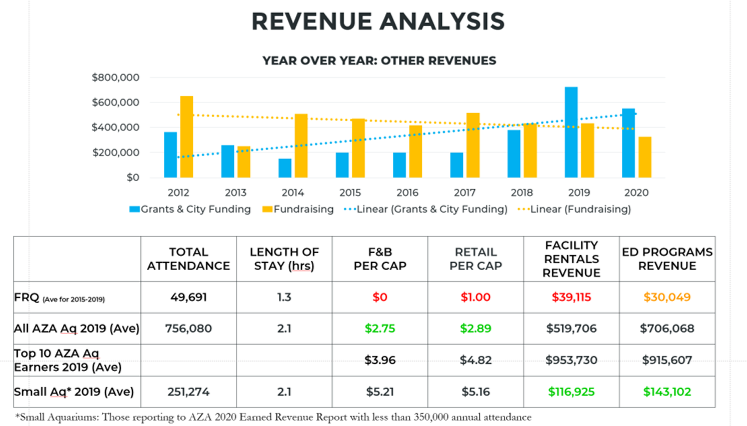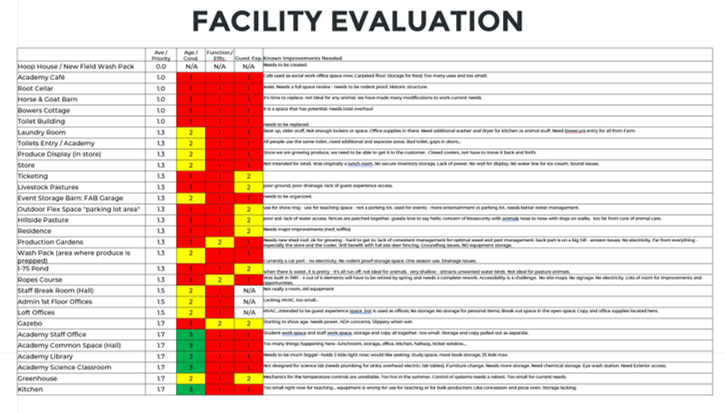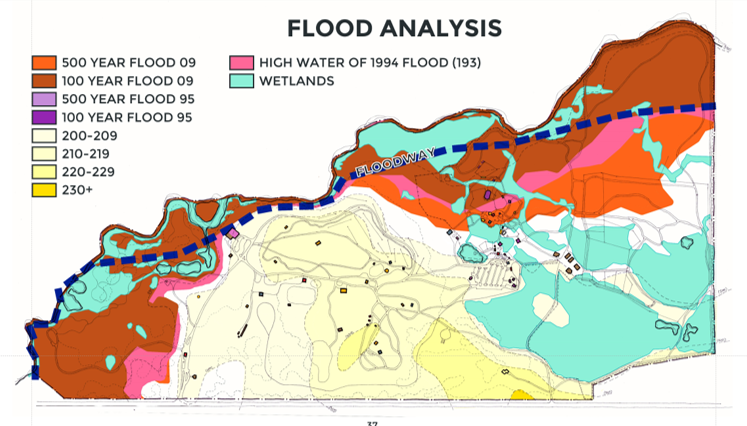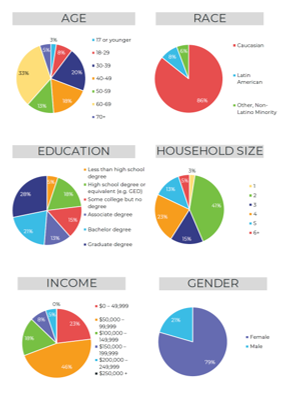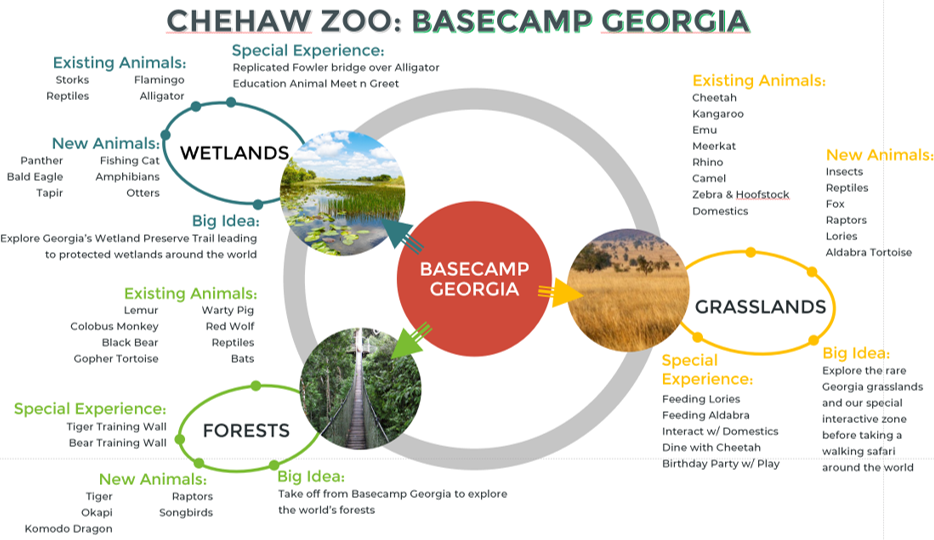master planning 101
In July 2023, I presented a continuing education webinar on the basics of Master Planning to the ZAA community. This post summarizes that presentation.
“Good master plans excite. Great master plans are implemented.”
If you’ve found your way to this post, it’s likely you’ve got questions about the process of master planning for zoos and aquariums. Over my 20 years of experience, let me tell you—I’ve heard them all. And as the saying goes, there are no stupid questions. Today, I attempt to answer your most pressing questions, hopefully clarifying the process and outcomes of one of the most important planning tool an animal organization can create.
What is a master plan?
Often when you see a zoo or aquarium’s master plan, you are looking at a site plan drawing of what the facility will look like in a specified amount of time, typically ten to twenty-five years. The first thing I’d like to impart is simply that a master plan, when done well, is so much more than just a drawing. It should address your facility holistically and include a robust analysis phase that examines everything from the site topography to your revenue streams to your competitive market. These combine to lay the foundation for the creative visioning of new facilities and experiences that seek to address the challenges of the current organization as a whole. More on that in a moment, but first I want to address a commonly confused form of planning: strategic planning.
Strategic plans (which can be done in-house) focus on creating an action plan for the short term (three to five years typically) for all aspects of the facility. This includes staffing, programs, revenues, amongst other things including facilities. Master plans use holistic assessments and visioning to create a physical plan for the long-term, often incorporating the strategies outlined in a strategic plan when available. Additionally, strategic plans often include action items directing the need for a master plan or the steps to implement a master plan. All of that is to say, strategic plans create a step-by-step roadmap for the entire organization while a master plan addresses only the physical plan and may be part of the strategic plan.
Another point of difference lies in who completes the work. While non-profit organizations will often create their strategic plans in-house or with the help of an outside facilitator, master plans are very rarely completed in-house and only should be completed in-house if your organization has a designer on staff. In both cases, the process is enhanced with the outside perspective of a consultant. Often the plans are perceived as more valid and carry more influence with donors, funders, and boards when utilizing an outside consultant.
So, what should be included in a master plan? It depends on your budget and the process of the consultant that you choose. I generally believe there are three buckets of services to consider: Minimum, Enhanced, and Add-Ons. At any budget level, you should expect to see at a Minimum the following services promised in a proposal for master planning: site analysis, thematic and / or message organization of the entire facility (i.e. zoogeographic zones), a site plan, artistic renderings, project phasing, and project budgets.
An enhanced level of planning could include the following: current and potential market analysis (i.e. audience segmentation), competitive market analysis, performance analysis (i.e. revenue streams), brand experience definition (i.e. architectural and site element look & character references, brand personality as it relates to guests’ on-site experience, etc.), zone design inspiration reference images, and project design program (which outlines how big each master plan element might be, what materials will be used, how barriers are constructed, etc.).
Finally, most master planners will offer additional services that often come with additional fees above a typical master plan process. These services are specialties and are not always needed in the process. Remember, every zoo and aquarium is different and thus has different requirements for creating the best possible master plan. Some of these services may include business planning (i.e. operating cost vs revenue projections), public engagement (including focus groups, community workshops and /or digital surveys), and coordination with strategic planning.
When should we begin?
If you are wondering when is the best time to start master planning, the easy ‘consultant marketing’ answer is now. However, that probably isn’t the right answer. The right time depends on many factors. I’ve developed a flow chart (below) that will help you answer that question, but here are some considerations.
If you don’t have a master plan or if your plan is eight to ten years old, you likely need to start as soon as possible. With an older plan, there are many considerations. Is this plan old, but you’ve been actively implementing it and you are getting to the end of the defined projects? If so, you may want to consider finishing your final project and giving your team some time to decompress and celebrate the successful implementation before beginning anew. If your plan is old and you have stalled or never really started implementing projects from it, then now is the time to begin again. We’ll want to discuss honestly ‘the why’ behind the lack of implementation in your previous plan so that we can create something that will actually work this time. I always say, a good master plan excites, but a great master plan is implemented.
Another major consideration has to do with changing circumstances. Whether or not you have implemented your plan, if you have had a major change in leadership or vision, or a large turn-over of staff, you may want to consider going through the process again and creating a fresh master plan reflecting the revised vision for the organization. Are changing regulations or animal availability affecting your current plan? Have you had to pivot or stray from the current plan due to unforeseen issues (i.e. Covid, anyone?), or have you had an unexpected infusion of funding for a project not included in the current master plan? Any change in the circumstances that created the current master plan may indicate a need for a new or refreshed master plan in the coming months.
Finally, while anytime of year is best to begin master planning—you should determine when would be the least distracting time of year for staff and stakeholders, if you are planning for AZA or ZAA accreditation, you should begin your master planning process at least one year ahead of when your application is due. AZA does now require an updated master plan for accreditation, and ZAA now recommends it.
Who should be involved?
Every zoo and aquarium leadership team is structured differently, and depending on the size or operating budget of your facility, you may have a group the size of a football team or as small as a doubles match in tennis to invite along for the process. In either case, I have found that strategically creating two groups of master planning participants with defined roles streamlines the process and helps define expectations for everyone involved.
First, you should define your “Core Planning Team.” This team is mainly comprised of zoo leadership staff and a few supportive stakeholders such as board members, very active volunteers, or highly engaged Friends members. This group will be the key decision-making team and will be expected to attend all meetings. They should have the time and capacity to review all documents in-depth, reflect on questions asked of them, and participate in a meaningful way to the process. I have found that this team works best when there are less than ten people, and ideally the group is five to seven. Typically, this team will include the CEO / Director, COO / Assistant Director, head of Education department, head of Animal Care, head of Marketing, and head of Finance, among others.
The second team you need to define is the “Master Plan Committee.” This larger group extends to a broader group of staff members, volunteers, board members, and potentially even donors. While the invitation to participate in this group is much wider, you should strategically select members who are interested and engaged in future planning. They will be invited to several meetings throughout the process for information gathering, feedback at specific milestones, and general status updates for buy-in. Ideally, this group adds another eight to ten people for specific meetings. However, this group, who brings a much wider range of perspectives, could be large enough to bring our total maximum group (Core + Committee) to no more than thirty members.
When it comes to who should be involved, you know best. I suggest including not only those who are excited about master planning and have great ideas, but also those who traditionally have been cynical or slow to change. Although sometimes challenging, the process has proven to be an excellent opportunity for those who may feel overlooked or unheard to be part of the decision-making process, building buy-in, and improving team communication and dynamics.
How long does it take?
The simple answer is six months minimum and, ideally, no more than one year. However, life happens and as you know, projects always encounter delays. What are some of the most common variables impacting length? I’m glad you asked.
First, the length of the master plan is directly related to the services included (see “What is a Master Plan?” above). Any add-on service will of course add time to the process. Public engagement is an add-on service that can be highly impactful to the schedule. Surveys take about a month from conception to results analysis. Public workshops and / or focus groups are the most variable dependent upon how much planning is required for these in-person meetings. Do you have a list of participants and methods for connecting with them? Are we creating elaborate testing or presentation materials? How far in advance do we need to schedule these based on participant or site availability? Further, public engagement is typically recommended at two points in the master plan: at the beginning to gather baseline information and later to test creative concepts in order to select projects for inclusion in the master plan. Schedule is impacted by whether we choose to include both touchpoints, or just one.
Another major impact on schedule relates to the complexity of decision-making. Public institutions (think, a city zoo within a parks department) often require multiple approvals beyond the master plan committee who are fully invested in the process. This can add time and complexity. What happens if the recommendations are rejected? How many tweaks do we need to make? How long does it take to simply get on the schedule of the decision-makers to get approval?
Other impacts relate to scheduling and focus of the planning team members. Like mentioned in “When should we begin?” consideration of individuals’ other tasks should be incorporated into the schedule. Are there particular known distractions that will preclude the team from reviewing reports and contributing meaningful thought? Are we planning the brainstorming session in the same week as spring break or summer camps? When is your big fundraising event and how many of the core master planning team are also in charge of that event? When are team members’ vacations?
Delays also occur right at the beginning of the process from writing and executing contracts, and from gathering necessary data and drawings needed for the master plan. Typically, these early delays can be avoided by preparing contracts ahead of time and knowing that consultants will need various information such as site survey (or plans of previous projects), previous master plans, revenue data, attendance data, guest surveys, organizational charts, animal collection plan, relevant AZA inspection reports, building inspections or evaluations, known projects lists, etc. which can be prepared while consultant selection occurs.
All of these will impact the schedule. Delaying meetings and deadlines by a week here and there ultimately delays the entire project.
What are the steps involved?
Of course, every consultant will have their own approach, but typically master plans can be broken down into three phases: Analysis, Creative Development and Implementation. Let’s explore what happens in each.
Analysis is the time your consultant gets to know you as an organization and discovers the challenges and opportunities of your facility. As discussed in part one, “What is a Master Plan?”, at a minimum analysis will dive into the issues related to the site. Additional analyses will include market studies, performance analysis, and visitor studies. During Analysis, you will no doubt be presented with a myriad of diagrams, spreadsheets, and graphs. In the end, only a few of these analyses will be critical to the final master plan, and those few will make the final cut. However, each analysis should be valued from the perspective of how it informed your consultant, in addition to confirming internal assumptions and thinking, and providing validity to the master plan to those not involved in the process. However, every master plan analysis that I’ve been involved with has had at least one moment that was surprising to the team, helping to see the facility in a different light, or revealing some insight staff were too close to see. This is one of the values of an outside consultant.
At the end of analysis, a succinct list of goals and strategies should be created to address the strengths and weaknesses outlined within the evaluation. These goals and strategies may address issues broader than what a physical master plan can address, but they should be as focused as possible to form the foundation upon which decision-making will progress within the master plan.
From this foundation, Creative Development begins. This is the process by which new facilities and experiences are developed. Each must be responsive to the goal or strategies outlined. We begin the process with a brainstorming session tailored to your organization based on the outcomes of the analysis phase. We may focus the brainstorm on wide brand experience discussions or the overall organization or story of your facility. We may focus on developing specific exhibits or facilities we know must be included in the master plan. We may focus on circulation or expansion of the site, if those are the critical issues. The important thing to remember is that the brainstorming workshop is a time for everyone to contribute to the solutions. From there, your consultant will produce various drawings and image boards to represent the overall organization of the master plan and dig into the specific additions or renovations required for long-term success. During this time, you may elect to conduct focus groups or concept testing with the community or targeted audience.
The transition from Creative Development to Implementation is often a blurry one with overlap between the two phases. Typically, during the Implementation phase, range of magnitude estimates leading to project budgets are developed, and projects are selected and prioritized. A project roll-out (or schedule) is developed where we determine the order of projects over the life of the master plan. Artistic renderings are often produced now (sooner if needed for concept testing), business plans are created, and final presentation materials are designed. Although this phase may seem the smallest, it often requires a lot of time and focus from you and your team with many internal discussions about priorities and realities of fundraising. You may also spend time reaching out to additional stakeholders and potential donors so that the team is fully informed before making final decisions about what projects to include in the master plan, if the plan is feasible, and how to achieve it.
What are the outcomes?
What should you expect to see in your final deliverable from your consultant? Let’s explore some possibilities.
Analysis diagrams, spreadsheets, and graphs will evaluate all aspects of the facility including site specific issues like topography, historic structures, parking, visitor circulation, service access and circulation, building evaluations, shade / sun studies, exhibit quality, visitor amenity locations, important trees and vegetations, etc. More in-depth evaluations will address your target audience with visitor and non-visitor demographics, drive-time analyses, and tourism stats and demographics. Performance evaluations would include attendance trends, annual attendance growth rates, education program attendance and growth, revenue per caps and growth rates, amongst others. Guest experience evaluations could include subjective and brand experience, messaging impact, retail experience, programs and events evaluations, etc., and competitive market evaluations of regional and national competition. If you elected to add public engagement, you’ll receive the data analysis and results from these.
Felis Consulting includes brand experience evaluation and subsequent brand experience look and character image boards and narrative descriptions. This is sometimes the basis for overall site organization, or it can serve as the ‘baseline’ zoo architecture, most successfully illustrated at an entry experience. Some small zoos and aquariums choose to forgo thematic, immersive exhibits or zones and use the brand experience as the continuous look and character of the entire public-facing facility. Either way, a brand experience board can be included in the final master plan package.
Along with the overall organization and/or brand experience, individual projects or zones will be defined with image boards and narrative descriptions. An additional tool for this is a project design program, which is typically a spreadsheet for each project defining the areas needed, barrier type for exhibits, pool sizes, etc. The project summary pages in a master plan define key elements, species, messaging, storyline, look & character inspiration and aspirations for each master plan project.
Of course, you will get a site plan! This is the essential piece of any master plan. Each consultant has their own style of drawing and rendering the plan, but it should include the new additions, renovations, revised circulation patterns, expansion areas, etc. that have been outlined for the extent of the master plan. Sometimes you will also see phased plans that show the evolution of the facility at specific increments, like every year or every 5 years.
You should receive spreadsheets that include project budgets and some version of a schedule with the individual projects assigned to years or phases of the master plan. You will also receive any artistic renderings that were completed at a size that is printable for fundraising events. I always also include attendance projections over the master plan’s life, and a final booklet and power point presentation which you can edit and reformat as needed for your various presentations and marketing materials. If you have added business planning to the services, you’ll receive projections for operating costs and revenues year over year resulting in profit and loss projections.
Why should we master plan?
Beyond the obvious reason for master planning (definition of projects for future growth), the process itself brings with it a plethora of benefits, helping you and your team answer critical questions.
Prioritization: Should we implement fully new projects or tackle deferred maintenance? Should we replace aging habitats or make small changes to enhance animal wellbeing? What animals should we continue maintaining in our collection? What animals do we need to start acquiring? Do we need to increase attendance, or should we focus on right-pricing and improving the revenue streams we already have? Can we tackle conservation and education mission while focusing on increasing revenues? Are there projects that have lower priority that logistically require implementation first in order to implement more impactful ones? When do we need to hire and how many positions?
Guest Experience: Do we have enough toilets, benches, shade, and other amenities to serve the basic needs of our guests today? What about at the end of the master plan? Will our retail shops and restaurants handle the anticipated growth over time? How can we deliver our key messages better? What is our story and how are we communicating it? How can we shape visitor perceptions of us and of the natural world? How can we improve staff efficiency and safety? How can we improve guest wayfinding?
Internal Operations: What data or knowledge are we missing collectively? What data should we begin collecting that will help us measure on-going success in the long-term? How can we work better together as a team? What are our teams’ weaknesses and how can we improve communication? Do we have different visions for the future of the organization, and can we align our vision toward a common goal?
Community: How are we perceived in the community? What partnerships do we need to improve upon? Are there new partners we haven’t explored yet? Can we improve our connection to the community around us? How can we better respond to our community’s needs or desires? Can we fill gaps in resources such as STEM learning opportunities or after-school programs?
Performance Growth: How can we improve penetration into our revenue opportunities across the site? Are we right-sizing and locating revenue opportunities? What are new opportunities for growth? What is a realistic expectation for revenue and attendance growth?
Additionally, the opportunity for your team to spend focused time and attention on defining your organization’s future will likely provide you with unexpected benefits we can’t predict. When completed strategically with thoughtfulness and intentionality, master plans are incredibly powerful tools for shaping your organization’s success—from fundraising and implementation to team dynamics and operations. Let’s begin yours today!










